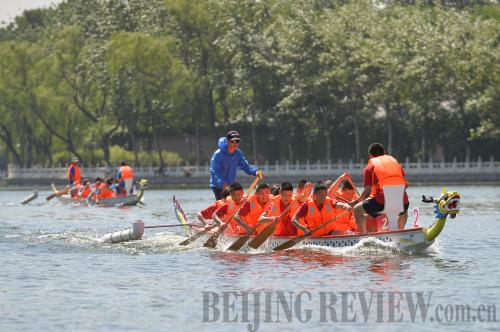|
 |
|
COMPETITION ON THE CANAL: Two dragon boat teams compete in the Shichahai Lake in Beijing, which is a part of the Grand Canal, to mark the Dragon Boat Festival on May 28 (LI XIN) |
Threading through Beijing's famous and bustling Shichahai area and running hundreds of meters eastward by the lakeside, one can see ruins of the ancient Dongbuya Bridge. Though the bridge itself is long gone, and the water level much lower than before, the flourishing trees, quiet atmosphere and zigzagging alleys still make the area a favorite spot for local residents and tourists alike.
The Dongbuya Bridge, once an important feature along China's Grand Canal, is just one artifact that will benefit from the canal's recent naming as a UNESCO World Heritage Site. At the 38th session of the UNESCO World Heritage Committee on June 22 in Doha, Qatar, the Grand Canal was officially added to the international organization's list, raising the number of Chinese sites on the roster to 47.
Ancient waterway
The World Heritage Committee cited the Grand Canal as the world's longest and oldest artificial waterway as well as the largest and most widespread civil engineering project undertaken before the Industrial Revolution. It reflects Chinese people's tremendous wisdom and resolution as well as Eastern civilization's early achievements in hydraulic engineering and project management. The canal has played a significant part in guaranteeing China's economic prosperity and social stability through the centuries.
In accordance with historical tradition, the Grand Canal is divided into 10 sections. The Beijing portion of the canal was first excavated during the Sui Dynasty (581-618) for grain transportation. What exists now of this section of the canal was largely excavated and drained during the Yuan (1206-1368), Ming (1368-1644) and Qing (1644-1911) dynasties. Until the year 1900, it had acted as an important grain transportation route for over 1,300 years. At the turn of the 20th century, the railway between Beijing and Tianjin came into operation and replaced the canal as the main mode of transportation. Today, the Beijing section includes 82 km of waterways and 24 sluices, and still runs through Beijing's six districts from Changping in the northwest to Tongzhou in the east.
Sites in the capital city selected for inclusion in the UNESCO listing are two waterways and two relics: parts of the Tonghui River in downtown Beijing and Tongzhou, and ruins from the Wanning and Dongbuya bridges.
Shao Jun, an official with the Department of World Heritage, the State Administration of Cultural Heritage, explained that only the sections in better condition and with more relevance to the canal as a whole were selected for World Heritage Site status. "All World Heritage Sites share an 'OUV principle': outstanding, universal and valuable," Shao told Beijing Review. "The basic rule is that the original site must be of some worth, is authentic and also complete. It cannot be selected after modern reconstruction." Like in other sections of the Grand Canal, only the best-preserved sites in the Beijing section were able to be included, Shao added.
The Grand Canal's success in being named a World Heritage Site has increased the variety of internationally recognized historical relics in Beijing, said Shu Xiaofeng, head of the Beijing Municipal Administration of Cultural Heritage. He added that it is significant in promoting the capital city's development as a cultural center. Beijing is now the Chinese city with the most World Heritage Sites.
|
